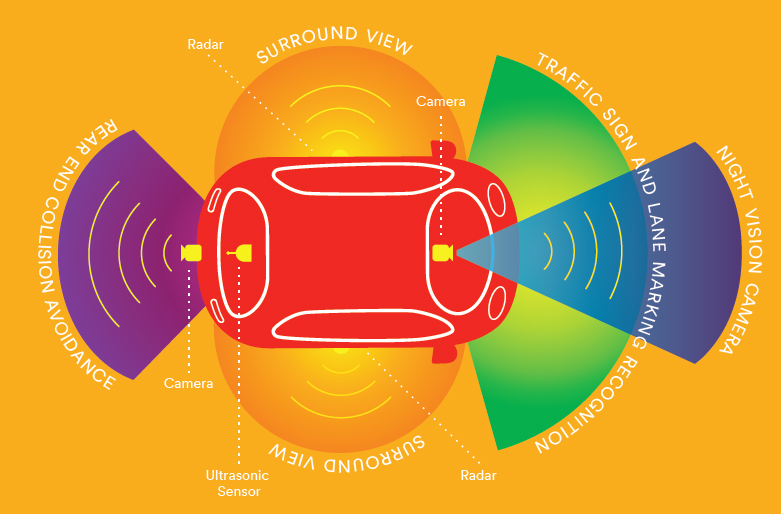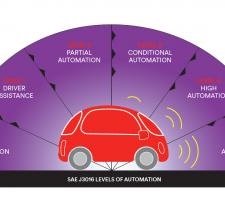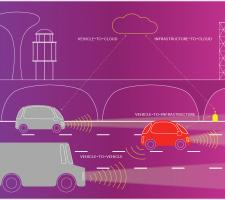
Tammy Meehan and Thomas Hedblom of 3M consider the ongoing development of technology needed to introduce connected and autonomous vehicles.
The transportation industry is in the midst of the most dramatic shift since Henry Ford introduced horseless carriages. Already we are seeing the increased use of advanced driver assistance systems (ADAS) which, along with the introduction of autonomous vehicles in the next few decades, will bring profound changes to vehicles and the environment in which they operate.
Well before fully autonomous vehicles and trucks can appear on the roads, work is underway to build an entirely new ecosystem needed for this technology to operate. This requires extensive research to create intelligent transportation materials and systems and is a collaborative effort between industry, academic institutions and government organisations. The current focus of the Traffic Safety and Security Division is on areas ranging from machine-readable and smart sign technology and more robust and visible pavement markings to wireless communications beacons and safer passage through construction zones.
Machine-readable
The future of transportation will require roadways to become readable by machines. Part of how this will be achieved are road markings that can be read by sensors to enable ADAS and autonomous systems to detect lines.
There is strong industry consensus that pavement markings play an integral role in moving to higher levels of automation. On February 21, 2017 the House Transportation Committee held a hearing on building infrastructure for the 21st century and invited comment from industry leaders. A written statement by BMW of North America CEO Ludwig Willisch stated that roadways must be properly prepared for autonomous cars so that vehicle sensors and cameras can read road markings and signage to make the correct decisions. Willisch added that well-maintained streets and uniform lane markings, as well as consistent signs and traffic signals, would be helpful in accelerating the deployment of [autonomous vehicles].
However, pavement markings do not provide the total solution. They form part of an overall system of redundancy which is critical to delivering improved safety via partially- or fully-autonomous vehicles. Redundancy in safety systems and standardisation of the infrastructure will be the backbone of a successful transition from the current environment to an environment where automated vehicles share the road.
Autonomous vehicle solution developers agree that at least four layers of redundancy are required to effectively process and utilise sensor-supplied information accurately and safely. While this does not necessarily mean four unique types of sensors, it does mean that multiple sensors and processes work together to provide an environment with backups to the backups to the backups.
Simply put, a single mechanism for governing an autonomous vehicle is too risky. Consider a vehicle using only GPS to navigate that loses the signal on entering a tunnel or while driving through an urban canyon, or after the satellite fails. Redundant systems ensure that additional mechanisms are in place to provide the information needed to continue operating safely even when the primary system fails. A principle that is already a standard in the aerospace industry, the concepts of redundancy and standardisation, is widely accepted by the ADAS standards committees and AOEMs (automotive original equipment manufacturers).
One example of active research in this area is a joint project between
“The Road Markings for Machine Vision Project illustrates the importance of collaboration in such the complex and uncharted territory of autonomous systems” noted Paul Carlson, research engineer at the Texas A&M Transportation Institute.
Another critical element of creating smarter infrastructure is systems that allow vehicles to interpret information, and central to this is the evolution of automated sensing and the infrastructure to be sensed. While traditional signs and pavement markings were designed for human vision, future infrastructure will need to provide information to both humans and sensing systems designed for ADAS and automated vehicles.
For its part, 3M is working on improving the visibility of pavement markings for both humans and machines across a variety of daylight and night-time conditions. In general, enhancements to pavement markings designed to improve detectability by the human eye also improve detection by an optical camera in a vehicle. In fact, a camera ultimately provides a more consistent evaluation of the pavement marking than the average human eye and both human and machine vision need to be supported for the foreseeable future. This drives a need for common objectives: pavement markings must exhibit sufficient levels of daytime contrast compared to the adjacent roadway surface, and provide enough retroreflectivity and colour contrast at night-time in ways that ensure both humans and camera systems can see the lines while driving.
Marking durability
The durability of the pavement markings is an important consideration to ensure consistent readability over time, especially in a variety of extreme weather conditions. The use of high-index microcrystalline ceramic beads in pavement markings has resulted in highly durable optics that are abrasion-resistant and can withstand mechanical challenges, such as sanding and salting. Not only are the ceramic beads harder than sand, they offer high dry reflectivity and wet retroreflectivity during daylight and at night-time. Now, researchers are working on the next generation to extend the warranted period for retained retroreflective performance from the current minimum of four years (in northern areas) and up to six years in southern non-snowplough states.
Another critical component of a infrastructure compatible with both ADAS and autonomous vehicles is developing road signs with improved readability for humans and camera-equipped vehicles. Next-generation signs will provide more data to drivers and automated vehicles as well as dynamic updates to the information should road conditions change.
To facilitate this development, 3M continues to enhance its Dedicated Short Range Communication (DSRC) Multi-Channel Test Tool, which verifies transmitted data and protocol for connected vehicle technology and service/application initiatives. It detects transmitting DSRC units (roadside or on board) and monitors the control, or service and dedicated safety channels. It can be used by equipment providers and DoTs to check wireless V2V, V2I) and V2X communications to ensure critical details of a changing environment are communicated accurately and rapidly to connected and automated vehicles [see illustration]. Future generations of passive signage will also contain embedded smart systems to provide additional and more relevant information to drivers.
Regulatory environment
The environment needed to enable autonomous vehicles is vast and enormously complex. To create an environment optimised for autonomous vehicles that can fulfil the promise of increased safety, the infrastructure needs to be developed in tandem with the expanded functionality being developed for vehicles. Multiple transportation industry stakeholders are working together to define the safety challenges that automated vehicles present, to set realistic expectations and to deliver lasting, permanent solutions.The US DoT published the Federal Automated Vehicles Policy in September 2016. In its words, “the excitement around highly automated vehicles (HAVs) starts with safety.” In 2015 alone, 35,092 people died on US roadways. Ninety-four percent of crashes are attributed to human choice or error.
Ultimately, the automated driving future is not just about the technology that OEMs put into their vehicles. It is about a broad and integrated system that allows cars to communicate with each other and with the driving ecosystem to keep drivers and other roadway users safe.
ABOUT THE AUTHORS: Tammy Meehan and Thomas Hedblom are respectively global portfolio manager, Intelligent Transportation and division scientist with 3M.











